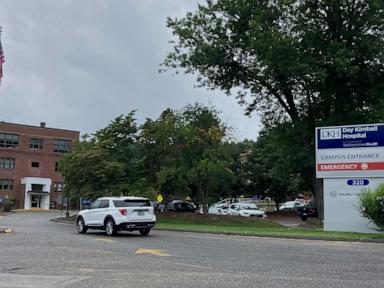
OMAHA, Neb. — Tyler Sherman, a nurse at a rural Nebraska hospital, is accustomed to seeing the area’s aging farmers delay medical care until they find themselves in his emergency room. With Congress contemplating approximately $1 trillion in Medicaid cuts over the next decade, Sherman fears that these farmers and the more than 3,000 residents of Webster County could lose not just the ER, but also the clinic and nursing home affiliated with the hospital.
“Our budget is pretty heavily reliant on the Medicaid reimbursement, so if we do see a cut of that, it’ll be difficult to keep the doors open,” said Sherman, who works at Webster County Community Hospital in the small Nebraska town of Red Cloud, just north of the Kansas border. If those facilities close, many locals would see their five-minute trip to Webster County hospital turn into a nearly hour-long ride to the nearest hospital offering the same services. “That’s a long way for an emergency,” Sherman said. “Some won’t make it.”
Impact on Rural Healthcare
States and rural health advocacy groups warn that cutting Medicaid — a program serving millions of low-income and disabled Americans — would severely impact already fragile rural hospitals, potentially forcing hundreds to close and leaving some people in remote areas without nearby emergency care. According to an analysis by the Cecil G. Sheps Center at the University of North Carolina at Chapel Hill, more than 300 hospitals could be at risk for closure under the Republican bill.
Even as Congress debated the controversial bill, a health clinic in the southwest Nebraska town of Curtis announced it will close in the coming months, partly blaming the anticipated Medicaid cuts. Meanwhile, Bruce Shay of Pomfret, Connecticut, fears he and his wife could be among those left in the lurch. At 70, they’re both in good health, but Shay worries that if either needs to go to a hospital, “it’s going to be an emergency.”
Financial Struggles of Rural Hospitals
Day Kimball Hospital, located nearby in Putnam, has faced recent financial challenges. Its CEO, R. Kyle Kramer, acknowledged that a Senate bill passed Tuesday — estimated to cut federal Medicaid spending in rural areas by $155 billion over 10 years — would further strain his rural hospital’s finances. Roughly 30% of Day Kimball’s current patients receive Medicaid benefits, a figure that’s even higher for specific, critical services like obstetrics and behavioral health.
“An emergency means I’m 45 minutes to an hour away from the nearest hospital, and that’s a problem,” Shay said. He and his wife wouldn’t be the only ones making that trip. “You’ve got, I’m sure, thousands of people who rely on Day Kimball Hospital. If it closed, thousands of people would have to go to another hospital,” he said. “That’s a huge load to suddenly impose on a hospital system that’s probably already stretched thin.”
Broader Implications of Medicaid Cuts
Rural hospitals have long operated on the financial edge, especially in recent years as Medicaid payments have continuously fallen below the actual cost to provide health care. More than 20% of Americans live in rural areas, where Medicaid covers 1 in 4 adults, according to the nonprofit KFF, which studies health care issues. President Donald Trump’s $4.5 trillion tax breaks and spending cuts bill, which passed Thursday, would exacerbate rural hospitals’ struggles by cutting a key federal program that helps states fund Medicaid payments to health care providers.
To help offset the lost tax revenue, the package includes $1.2 trillion in cuts to Medicaid and other social safety net programs — cuts they insist only root out fraud and waste in the system. However, public outcry over Medicaid cuts led Republicans to include a provision that will provide $10 billion annually to support rural hospitals over the next five years, or $50 billion in total. Many rural hospital advocates are wary that it won’t be enough to cover the shortfall.
Expert Opinions and State-Specific Impacts
Carrie Cochran-McClain, chief policy officer with the National Rural Health Association, said rural hospitals already struggle to break even, citing a recent American Hospital Association report that found that hospitals in 2023 received nearly $28 billion less from Medicaid than the actual cost of treating Medicaid patients.
“We see rural hospitals throughout the country really operating on either negative or very small operating margins,” Cochran-McClain said. “Meaning that any amount of cut to a payer — especially a payer like Medicaid that makes up a significant portion of rural provider funding — is going to be consequential to the rural hospitals’ ability to provide certain services or maybe even keep their doors open at the end of the day.”
A KFF report shows 36 states losing $1 billion or more over 10 years in Medicaid funding for rural areas under the Republican bill, even with the $50 billion rural fund. No state stands to lose more than Kentucky. The report estimates the Bluegrass State would lose a staggering $12.3 billion — nearly $5 billion more than the next state on the list. This is due to the bill ending Kentucky’s unique Medicaid reimbursement system and reducing it to Medicare reimbursement levels. Kentucky currently has one of the lowest Medicare reimbursement rates in the country and one of the highest poverty rates, leading to a third of its population being covered by Medicaid.
Kentucky Gov. Andy Beshear, a two-term Democrat widely seen as a potential candidate for president in 2028, said the bill would close 35 hospitals in his state and pull health care coverage for 200,000 residents.
“Half of Kentucky’s kids are covered under Medicaid. They lose their coverage and you are scrambling over that next prescription,” Beshear said during an appearance on MSNBC. “This is going to impact the life of every single American negatively. It is going to hammer our economy.”
Looking Ahead
The proposed Medicaid cuts have sparked significant concern across rural America, highlighting the delicate balance many rural hospitals maintain to stay operational. As lawmakers continue to debate the future of healthcare funding, the potential consequences for rural communities remain a critical point of discussion. The outcome of these legislative efforts will undoubtedly shape the healthcare landscape for millions of Americans living in rural areas.







